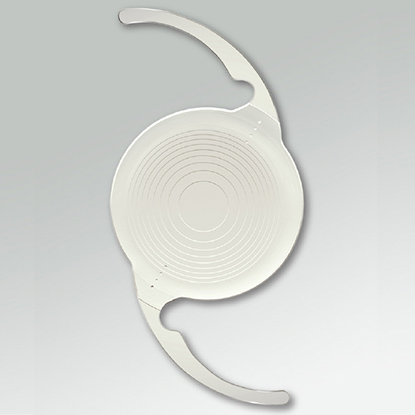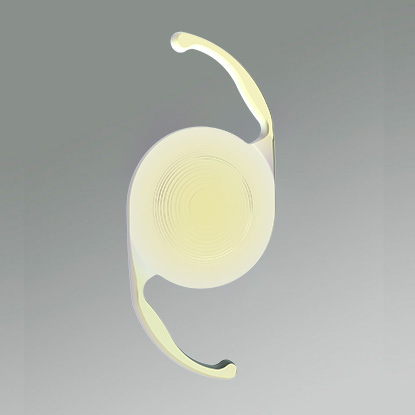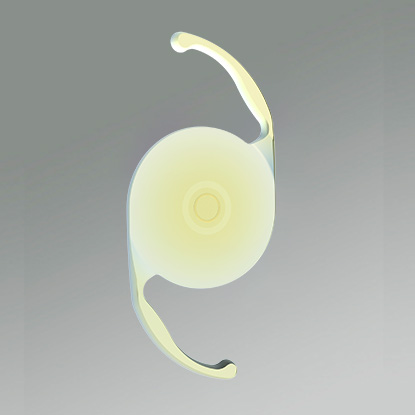



Advances in cataract surgery have led to innovative technologies and multiple types of intraocular lenses (IOLs) to restore clear vision. In the past, eye surgeons were limited in the treatment options available to improve both close vision and distance vision. Now, different IOLs are available to address the vision problems of each individual patient undergoing cataract surgery.
There are four types of IOLs available to enhance your vision. Monofocal lenses help correct vision at a specific distance, multifocal lenses can correct vision up-close, in between and at a distance, toric lenses can correct astigmatism, and extended depth of focus lenses can improve your range of vision while also correcting numerous vision problems. Learn more about these types of intraocular lenses below.
Monofocal lenses can improve your vision by providing a single zone of clear focus. Monofocal IOLs are available for near focus, mid-distance and distant focus, depending on the needs of each particular patient. Monofocal lenses are designed to improve one zone of vision. Patients with monofocal lenses will still require glasses for other distances.
Multifocal lenses can provide a broader range of vision, allowing patients to see at near, far and intermediate distances. Unlike monofocal lenses, which focus on one zone of vision, multifocal IOLs can improve vision across all distances. Patients with multifocal lenses may not need glasses, depending on the specifics of treatment.
Toric lenses are specially designed to correct astigmatism. Astigmatism refers to an eye defect that is caused by an abnormality in the shape of the cornea. This abnormal corneal shape leads to a refractive error (when light does not focus properly onto the retina), resulting in blurry vision. Toric lenses are specifically shaped to focus light properly and correct the effects of astigmatism. Advanced toric IOLs can correct both astigmatism and cataracts.
Extended depth of focus (EDOF) lenses are revolutionary IOLs that can enhance your range of vision, as well as your overall depth of focus. These intraocular lenses can achieve crisp, high-quality vision across all distances. Extended depth of focus lenses, such as the TECNIS Symfony® line of IOLs, can also correct a variety of vision problems, including cataracts, presbyopia, and astigmatism.
As we grow older, our bodies mature and change naturally. Within the aging eye, these changes often develop into conditions that impact the quality of your vision. But if you're experiencing age-related visual problems, don't give up – with successful treatment, it may be possible to have clearer, brighter and sharper vision than you've had for a long, long time.



A cataract is a change in the clarity, or a "clouding," of the lens in your eye. Your crystalline lens, which is made mostly of protein and water, can become clouded enough to prevent light and images from reaching the retina. A cataract can be the reason sharp images become blurred and seeing things at night becomes more difficult. More than half of all Americans age 65 and older have a cataract, and cataracts are the leading cause of treatable blindness. For more on cataract treatment, read about cataract surgery.
Cataract-aged patients may also have a condition known as presbyopia. As people enter their 40s, they may experience blurred vision when performing everyday "close-up" tasks such as reading, sewing or working at the computer. This condition, called presbyopia, occurs as the lens in the eye becomes less flexible, and the muscles controlling the lens weaken. This is why some people need reading glasses or need to hold objects farther away to see them.
Some patients also have astigmatism, or a deviation in the shape of the cornea. Typically, the cornea is smooth and spherical, which allows light to properly refract. Astigmatism is caused by a misshaped cornea, which prevents light from properly focusing onto the retina. Astigmatism can lead to blurry vision or double vision.

TECNIS Symfony® IOLs are a breakthrough in intraocular lens technology. TECNIS Symfony® IOLs are the first extended depth of focus intraocular lenses. Unlike traditional monofocal IOLS, which only correct a specific zone of vision, TECNIS Symfony® lenses provide a wide range of high-quality vision – close-up, far away and at intermediate distances.
In today's fast-paced, technological world, people are constantly shifting focus from phones to tablets to a variety of other screens. When you are younger, you are typically able to change focus between distances seamlessly. However, your ability to focus on objects at certain distances may diminish naturally as you age, leading to the need for glasses. While traditional monofocal lenses can achieve clear vision at a single distance, patients usually still require glasses to see at other distances. Thanks to revolutionary technological advancements, there is now a way to see clearly across multiple distances without having to rely on glasses. TECNIS Symfony® lenses can provide sharp, continuous vision for patients who are having difficulty seeing at different distances.
TECNIS Symfony® intraocular lenses can treat a wide variety of vision problems. TECNIS Symfony® IOLS can correct cataracts and presbyopia, while TECNIS Symfony® Toric lenses can also correct astigmatism. Additionally, TECNIS Symfony® IOLs can provide crisp vision during daytime activities and low-light activities by correcting color distortion.
TECNIS Symfony® lenses create an area of elongated focus thanks to their diffractive echelette design; this innovation results in a wider range of vision. Additionally, TECNIS Symfony® IOLs have achromatic technology to correct chromatic aberration and greatly enhance image contrast for a clearer view.
TECNIS Symfony® IOLs can reduce the need for glasses; many patients do not need to wear glasses at all following the placement of their intraocular lenses. TECNIS Symfony® lenses are built with longevity in mind. Unlike other IOL materials, TECNIS Symfony® lenses are not associated with long-term glistening that can contribute to the scattering of light and a reduction in image contrast.
TECNIS Symfony® IOLs were shown to greatly improve intermediate and near vision in clinic trials, when compared with standard monofocal IOLs. Studies also showed that TECNIS Symfony® lenses had low incidences of glare and halos around lights at night - making it a versatile option for patients seeking to improve their vision no matter the time of day.

Clareon® PanOptix® intraocular lens (IOL) utilizes the latest, most advanced trifocal technology to provide clear and sharp vision, optimizing your ability to see at far, intermediate, and near distances. PanOptix® is the first and only trifocal lens available in the United States, giving you a full range of vision and reducing the need for wearing glasses.
A trifocal lens is a type of IOL that contains three different prescriptions within one lens. The purpose of an intraocular lens is to replace the natural lens of the eye following cataract surgery, restoring the function of the eyes for better visibility and to easily see near and far without strain.
The three-lens integration model used by PanOptix® lenses eliminates the need for ophthalmologists to target monovision, which is when one eye is more dominant at a certain viewing distance than the other eye. Monovision is very common and typically requires two different prescriptions for each eye, or two different monofocal lenses.
The key difference between trifocal lenses and a traditional monofocal lens, which are the basic level of cataract replacement lenses, is that monofocal lenses only refine and enhance your vision at one distance, rather than all three. With the PanOptix® trifocal lens, vision in both eyes can be improved at all distances.
The PanOptix® lens leverages advanced diffractive optics to distribute light appropriately across these focal points, resulting in reduced dependency on glasses for daily activities. Patients who undergo cataract surgery with the Clareon® PanOptix® IOL often report enhanced visual clarity and a seamless transition between different distances.

Clareon® Vivity® IOL (Intraocular Lens) is a cutting-edge innovation in the field of ophthalmology, designed to address the evolving needs of patients undergoing cataract surgery. Clareon® Vivity® is an extended depth of focus (EDOF) intraocular lens (IOL), which is used to replace the natural lens of the eye following cataract surgery. EDOF lenses are defined as creating a single, elongated focal point within the retina that enhances the depth of focus. The Vivity® EDOF lens provides patients with a wide range of focal vision at distances and intermediate depths without being a multifocal lens.
EDOF lenses avoid overlapping vision at varying distances and eliminate the halo effect caused by diffraction by blending the light that enters the eye into the singular focal point. The EDOF technology of Vivity® lenses can provide sharper, clearer vision and help lessen the dependence on glasses or contact lenses following cataract surgery.
Vivity® differs from PanOptix® as it is a type of monofocal lens, which remains as the standard cataract replacement lens. The Clareon® Vivity® intraocular lens provides clear vision at far and intermediate distances, and a functional level of near-sighted vision abilities.
This advanced lens provides patients with the potential for clear vision across a range of distances, reducing or even eliminating the dependence on glasses for activities such as reading, using a computer, and driving. The proprietary design of Clareon® Vivity® optimizes light distribution, resulting in enhanced contrast sensitivity and improved overall visual acuity. With its innovative features, this intraocular lens improves post-cataract surgery outcomes, offering patients the opportunity for a more seamless and natural visual experience.
Toric lenses are designed to address both cataracts and astigmatism. Both of these eye conditions are fairly common - roughly a third of the population experiences astigmatism and more than half of people age 65 or older develop cataracts. Toric IOLs are unique in their ability to treat both of these eye problems at once.
Unlike other intraocular lenses, toric lenses specifically address the effects of astigmatism. Astigmatism refers to an eye defect that results in an abnormally-shaped cornea. Instead of the typical, round shape of a cornea, an astigmatic cornea is shaped like a football. This irregular shape bends light that enters the eye, changing the way light focuses onto your retina. As a result, astigmatism causes your vision to be blurry or distorted across multiple distances. Toric IOLs can correct astigmatism by properly reflecting the light that passes through your eye onto the retina. By bending light the proper way, your toric lenses can restore clarity and reduce blurriness.
Advanced toric IOLS can also act as a natural lens following cataract surgery to help patients restore crisper vision. Cataracts occur when the proteins found in the natural lens of your eye build up, causing a cloudy, opaque covering of the lens. Cataracts are usually a result of the natural aging process and are very common. Toric intraocular lenses can effectively replace the clouded lens. Your cataract surgeon will remove the clouded lens using advanced technology and then insert the toric lens into the eye to restore clear vision.
A toric intraocular lens can treat both cataracts and astigmatism - making it the preferred choice for patients experiencing both of these eye conditions. In the past, many traditional IOLs were designed to treat cataracts exclusively; patients with astigmatism would usually require an additional procedure to restore their vision. Now, toric intraocular lenses are available to address the cloudiness of cataracts and the distorted vision caused by astigmatism. One lens can now treat two conditions in a quick and routine procedure. Dr. Filer offers a variety of advanced toric IOLs for patients with cataracts and astigmatism.
To learn more about advanced cataract technologies and IOLs, contact our San Mateo office at 650.342.4595 or request an appointment today.